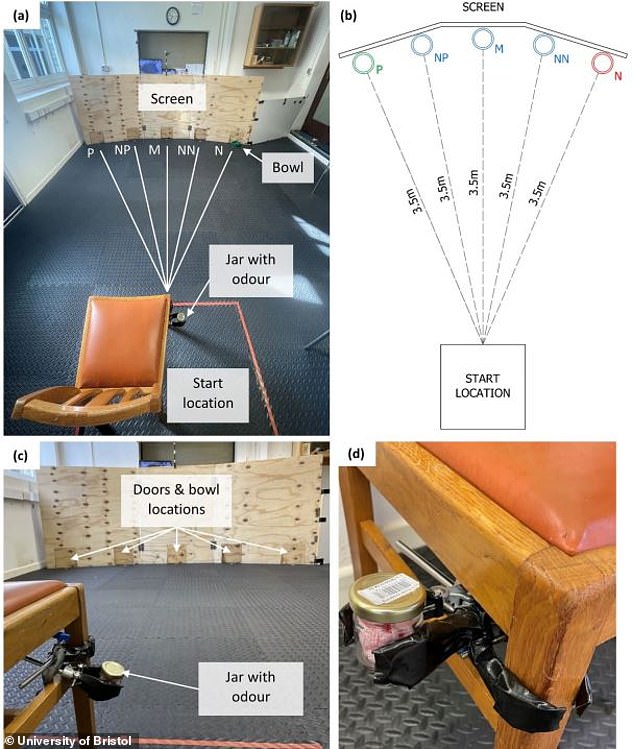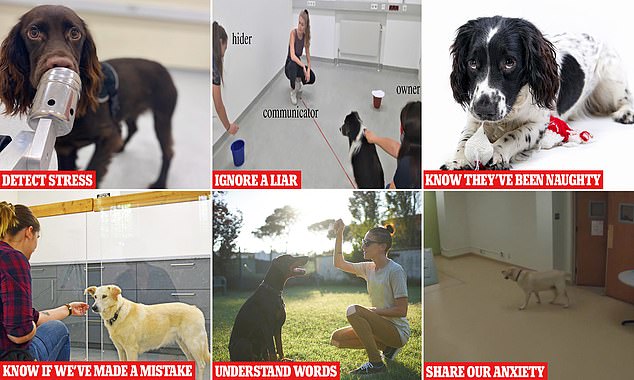The uncanny ability our four-legged friend has to know when we are in a bad mood is something that dog owners have long trusted.
However, scientists have now shown that dogs are actually affected by their owners’ emotions.
Researchers at the University of Bristol have discovered that dogs’ behaviour changes depending on the scent of stress in our sweat and breath.
Dogs that smelled a stressed human also had a more “pessimistic” outlook on life.
Lead author Dr Nicola Rooney said: “Working dog trainers often describe stress as being transmitted on the leash, but we have also shown that it can travel through the air.”
Researchers have found that dogs become more pessimistic when they smell stressed humans. In a trial involving 18 dogs (pictured) they were found to make less optimistic decisions after smelling the scent of stress.
Previous research on dogs’ emotions has suggested that they are particularly sensitive to the moods and actions of those around them.
However, what had not yet been demonstrated was whether smell played any role in the propagation of these emotional states.
Dr Rooney says: ‘Dog owners know how in tune their pets are with their emotions, but here we show that even the scent of a stressed, unfamiliar human affects a dog’s emotional state, perception of rewards and ability to learn.’
To test this theory, the researchers recruited 18 human-dog pairs to participate in a series of trials.
First, the dogs were trained to recognize the difference between a good and a bad situation.

The dogs were trained to know that in some locations there were treats in the bowls and in others there were not. To measure the dog’s optimism, a bowl was placed in a new location while the researchers measured how quickly the dog approached it.
When a food container was placed in one location, it contained a treat, but when an identical container was placed in a second location, it was empty.
Once the dogs learned the difference between these locations, they were quicker to approach the spot containing the treat than the empty spot.
When they placed a third container in a new location, the researchers measured how long it would take the dog to go investigate.
If the dog was going fast, it was a sign that they were optimistic that the container would have a treat.
On the contrary, the more reluctant the dog was to go and check if there was food in the new bowl, the more pessimistic his attitude was.

Researchers say dogs’ ability to detect human stress may have evolved to help them conserve energy and avoid disappointment (file image)
During the trial, dogs completed the same test while exposed to sweat odors and breath samples taken from humans other than their owners.
These odors were collected while human participants were either relaxing by listening to soundscapes or stressing out by performing an arithmetic test.
The researchers found that dogs that had been exposed to stressful odors were significantly less likely to approach the bowl to check it out, regardless of its location.
However, when given the scent of a relaxed human, the dogs went to the bowls more often than when given a neutral-smelling cloth.
Subsequent trials also showed that the dogs continued to improve at recognizing the location of the bowls and learned the difference more quickly when exposed to a stressful odor.

Researchers found that dogs were less likely to approach a container in a new location if they could smell a stressed human. But if they smelled a calm human, the dogs were more positive and more likely to try a new container.
Lead author Dr Zoe Parr-Cortes told MailOnline: “As one of our closest companions, dogs have co-evolved alongside humans for thousands of years.”
This causes dogs to experience a phenomenon called “emotional contagion” in which they adopt the moods of their owners.
“This can be beneficial as a perceived threat to another group member could signal a threat to themselves; therefore, detecting and responding to fear or ‘alarm’ in others may be advantageous in avoiding a common threat,” explains Dr Parr-Cortes.
Dogs may have developed this “pessimistic response” to human stress to conserve energy and avoid disappointment.
Researchers say the discovery could help professional dog trainers and owners understand how their own emotions affect their dogs’ training.
This could be an important consideration for dogs working in high-stress roles, such as police work or search and rescue operations.

As dogs have evolved alongside humans, they have developed several incredible skills to communicate and understand their human companions, including sensing our emotions.
However, social contagion could also be just as important for the average owner training a puppy.
Dr Parr-Cortes adds: ‘Human stress can make them less likely to try something risky if they think they will be disappointed.
‘The relaxing scent did not have this effect, so staying calm or even doing a relaxing activity before training your dog might reduce this effect.’
While previous studies have shown that dogs have some reactions to other human emotions, there are still no studies on how these affect optimism and pessimism.
In the future, the researchers say they would like to study the effect of emotions such as happiness or deep relaxation on dogs’ moods.
This research was published in Scientific reports.


